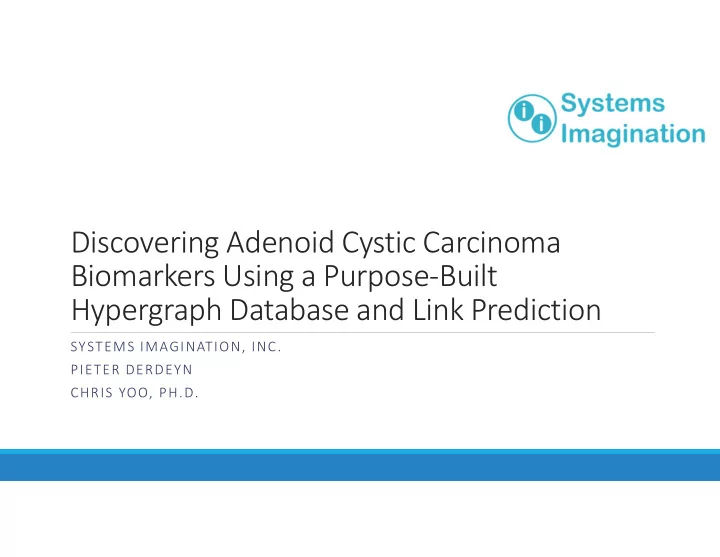

Discovering Adenoid Cystic Carcinoma Biomarkers Using a Purpose-Built Hypergraph Database and Link Prediction SYSTEMS IMAGINATION, INC. PIETER DERDEYN CHRIS YOO, PH.D.
Mapping Big Data
Maps throughout history…
How do we map cancer?
Dr. Michel, 40 years of biochemistry in one map ◦ Data management - linking data into a useful framework ◦ Interpretation of the meaning of the data in context Dr Gerhard Michal,Editor of the Roche Biochemical Pathways
A Hypergraph Map of Cancer Represent the data as knowledge – what’s the best way? Hypergraph MYB MYB – NFIB ACC Fusion GO:0008150 NFIB (Biological Process)
Populating the hypergraph Multiple sources Requires harmonization
Use Case: Adenoid cystic carcinoma (ACC) Rare (~1200/yr in US) Majority of ACC cases display activation of MYB, commonly through genomic translocation event with NFIB, both transcription factors Initial prognosis with surgery is good (5yr: 89%) but long term follow up indicates aggressive recurrence (15yr: 40%) What data can be examined to find hypotheses to explain these results?
Target: Gene fusions Hybrid gene from two previously separate genes (Wikipedia) Are often oncogenes because they lead to much more active abnormal proteins than normal genes MYB+MYB1+NFIB
Gene fusions – Data Sources
Link Prediction For a given pair of nodes, we would like to predict whether they have a certain edge type connecting them For example, what is the likelihood that Lily works at Systems Imagination? Works at Li University of Arizona Has written a paper with Jane Ryan Systems Imagination Lily
Link Prediction Train a supervised learning model using topological features like: ◦ Path counts ◦ Metapath counts Li University of Arizona Jane Ryan Systems Imagination Lily
Link Prediction Network Schema – a representation of all node types (metanodes) and the edge types (metaedges) between them Works at Scientist Institution Has written a paper with
Link Prediction – Gene Fusions Controls expression Participates Member of Related to Biological Gene Gene Cancer Process Fusion
Link Prediction – Gene Fusions MYB MYB-NFIB ACC Gene Fusion NFIB BP1 SIM1 BRK1 BP2
Hyperedge Prediction – Gene Fusions MYB MYB-NFIB ACC Gene Fusion NFIB BP1 SIM1 SIM1-BRK1 Gene Fusion BRK1 BP2
Mining Heterogenous Information Networks Hetionet Cancer Research Hypergraph David Himmelstein Systems Imagination, Inc. et al. 47,000 nodes 695,464 nodes 11 metanodes 16 metanodes 2,250,000 edges 12,007,912 edges 24 metaedges 41 metaedges Himmelstein et al
Nodes and Edges
Paths Predictions
Gene Fusion Prediction Pipeline For a given pair of genes, are they in a gene fusion or not? Dataset: Cancer Research Hypergraph Database Features: DWPC (Degree Weighted Path Count), Degrees of nodes, prior likelihood of gene fusion Supervised Learning Models: Random Forest, Logistic Regression, Decision Trees, XGBoost, Neural Networks Model Interpretation: Assess predictions, feature analysis
Challenges Data integration: Feature computation: Integrating data from dozens of 10 times the data, 100 times the sources and converting between computational cost 3 different formats
Strategies NVIDIA DGX ◦ 40 CPUs ◦ 256 GB RAM ◦ 4 x Tesla V100 GPUs (64GB memory total) Can do production level computation locally
Results Systems Imagination Benchmarking Neural Net Training on NVIDIA DGX 25 Dense NN built with mxnet and keras 20 7 hidden layers with 200-700 neurons 15 each 10 33,658,931 rows of data 5 18 features 0 6 classes 1 GPU NVIDIA DGX Time Spent (hours)
Strategies Multi-processing: 3 lines of python code sped processing up by 6 times GPU acceleration: ◦ Accelerated numpy computations by 10 times by moving to CuPy ◦ Accelerated deep learning 20 times by using mxnet on NVIDIA DGX Profiling and Debugging code: what is the bottleneck and how can I relieve it ◦ Rabbit hole: Not optimizing just the code, but optimizing the time spent developing and running the code
Results Gene 1 Gene 2 Probability of Gene Fusion EWSR1 HMGA2 0.929894619 BBS9 KMT2A 0.928350421 IQCJ KMT2A 0.927711269 CYP11B1 KMT2A 0.926647616 KMT2A TCIRG1 0.912818918 KMT2A VEPH1 0.911844923 CCR6 KMT2A 0.873986434 KCNQ1 KMT2A 0.834963505 ACSL1 KMT2A 0.834097153 EWSR1 RUNX1T1 0.832868597
Results Predictions
Results Predictions
The Team
Recommend
More recommend